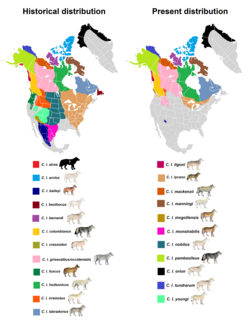| Bernard's wolf | |
|---|---|
 | |
| Scientific classification | |
| Kingdom: | Animalia |
| Phylum: | Chordata |
| Class: | Mammalia |
| Order: | Carnivora |
| Family: | Canidae |
| Genus: | Canis |
| Species: | |
| Subspecies: | †C. l. bernardi |
| Trinomial name | |
| †Canis lupus bernardi Anderson, 1943 | |
 | |
| Historical and present range of gray wolf subspecies in North America | |
| Synonyms [1] | |
| |
Bernard's wolf (Canis lupus bernardi), also known as the Banks Island wolf or the Banks Island tundra wolf, [2] is an extinct subspecies of the gray wolf that was limited to Banks and Victoria Island of the Arctic Archipelago. [3]










